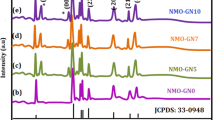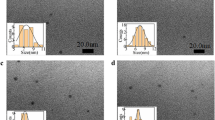Abstract
Nanostructured materials have significantly influenced numerous scientific and technological areas, mainly due to the tuneability of their optical and electrical properties. When working with quantum dots (QDs)-based thin films, the high prevalence of trap states and low conductivity has been a remarkable challenge, which has been addressed by the fabrication of hybrid materials. However, on the road to improving their properties, fabrication of nanostructured hybrid materials, especially when involving 2D nanomaterials, still poses a challenging task, particularly when solution-processed approaches are considered. In the current work, the fabrication of a solution-processed QDs-2D nanomaterial hybrid, comprising PbS QDs and thermally reduced graphene oxide (rGO) is discussed. This study explores the nanostructured hybrid material's behavior when varying the weight percent ratio between the constituents, revealing a substantial impact of this parameter on the optoelectronic properties of the resulting hybrid material; particularly affecting the photogenerated charge carrier transfer, charge carrier mobility, charge carrier concentration and resistivity. Physical characterization of the hybrid material revealed a dramatic change in the interaction between the PbS QDs and the rGO as the weight percent of rGO increased in the hybrid material, showing a clear reduction of PbS QDs coverage on rGO’s surface, which also produced an increment in the signals related to the oxidation of PbS QDs and rGO. The sample with 5% wt. of rGO showed optimal optoelectronic properties for possible applications in photodetector technologies or solar cells, displaying a high photogenerated current with a charge carrier mobility, charge carrier concentration, and resistivity of approximately 2.26 cm2/V-s, 1.27 × 1014 cm−3 and 2.18 × 104 Ω-cm, respectively. These findings serve as a foundational basis for the development of efficient optoelectronic devices based on this type of nanostructured hybrid material.








Similar content being viewed by others
Data availability
The authors confirm that the data supporting the findings of this study are available within the article and its supplementary information.
References
Chen W, Chen S, Ni ZH (2010) Band-bending at the graphene–SiC interfaces: effect of the substrate. J Appl Phys 49(1S):01AH05
Chen C, Li F, Zhu L, Shen Z, Weng Y, Lou Q, Wang M (2020) Efficient and stable perovskite solar cells thanks to dual functions of oleyl amine-coated PbSO4 (PbO) 4 quantum dots: Defect passivation and moisture/oxygen blocking. Nano Energy 68:104313
Chi S, Li Z, Xie Y, Zhao Y, Wang Z, Li L, Yu H, Wang G, Weng H, Zhang H, Wang J (2018) A wide-range photosensitive weyl semimetal single crystal-TaAs. Adv Mater 30(43):1801372. https://doi.org/10.1002/adma.201801372
Englert JM, Vecera P, Knirsch KC, Schäfer RA, Hauke F, Hirsch A (2013) Scanning-Raman-microscopy for the statistical analysis of covalently functionalized graphene. ACS Nano 7(6):5472–5482
Franklin AD (2015) Nanomaterials in transistors: From high-performance to thin-film applications. Science 349(6249):aab2750
Gómez EV, Guarnizo N, Perea JD, Lopez A, Prías Barragán JJ (2022) Exploring molecular and electronic property predictions of reduced graphene oxide nanoflakes via density functional theory ACS. Omega 7(5):3872–3880
Green PB, Narayanan P, Li Z, Sohn P, Imperiale CJ, Wilson MW (2020) Controlling cluster intermediates enables the synthesis of small PbS nanocrystals with narrow ensemble line widths. Chem Mater 32(9):4083–4094
Hines MA, Scholes GD (2003) Colloidal PbS nanocrystals with size-tunable near-infrared emission: observation of post-synthesis self-narrowing of the particle size distribution. Adv Mater 15(21):1844–1849
Jamkhande PG, Ghule NW, Bamer AH, Kalaskar MG (2019) Metal nanoparticles synthesis: an overview on methods of preparation, advantages and disadvantages, and applications. J Drug Deliv Sci Technol 53:101174
Kecsenovity E, Endrődi B, Tóth PS et al (2017) Enhanced photoelectrochemical performance of cuprous oxide/graphene nanohybrids. J Am Chem Soc 139:6682–6692
Kundu J, Ghosh Y, Dennis AM, Htoon H, Hollingsworth JA (2012) Giant nanocrystal quantum dots: stable down-conversion phosphors that exploit a large stokes shift and efficient shell-to-core energy relaxation. Nano Lett 12(6):3031–3037
Lan C, Li C, Wang S, He T, Zhou Z, Wei D, Liu Y (2017) Highly responsive and broadband photodetectors based on WS 2–graphene van der Waals epitaxial heterostructures. J Mater Chem C 5(6):1494–1500
Lara-Canche AR, Garcia-Gutierrez DF, Torres-Gomez N, Reyes-Gonzalez JE, Bahena-Uribe D, Sepulveda-Guzman S, Garcia-Gutierrez DI (2020) Solution processed nanostructured hybrid materials based on PbS quantum dots and reduced graphene oxide with tunable optoelectronic properties. Nanotechnology 32(5):055604
Lara-Canche AR, Vinayakumar V, Garcia-Gutierrez DF, Martinez-Guerra E, Garcia-Gutierrez DI (2023) Energy band alignment engineering in nanostructured hybrid materials based on PbS QDs and reduced graphene oxide: enhancing photodetector device performance. J Alloy Compd 932:167707
Lee EM, Tisdale WA (2015) Determination of exciton diffusion length by transient photoluminescence quenching and its application to quantum dot films. J PhysChem C 119(17):9005–9015
Li W, Shi J, Zhang KH, MacManus-Driscoll JL (2020) Defects in complex oxide thin films for electronics and energy applications: challenges and opportunities. Mater Horiz 7(11):2832–2859
Lunt RR, Giebink NC, Belak AA, Benziger JB, Forrest SR (2009) Exciton diffusion lengths of organic semiconductor thin films measured by spectrally resolved photoluminescence quenching. J Appl Phys 105(5):053711
Machol JL, Wise FW, Patel RC, Tanner DB (1993) Vibronic quantum beats in PbS microcrystallites. Phys Rev B 48(4):2819
Marcano DC, Kosynkin DV, Berlin JM, Sinitskii A, Sun Z, Slesarev A et al (2010) Improved synthesis of graphene oxide. ACS Nano 4:4806–4814
Martín-García B, Bi Y, Prato M, Spirito D, Krahne R, Konstantatos G, Moreels I (2018) Reduction of moisture sensitivity of PbS quantum dot solar cells by incorporation of reduced graphene oxide. Sol Energy Mater Sol Cells 183:1–7
Parveen K, Banse V, Ledwani L (2016) Green synthesis of nanoparticles: their advantages and disadvantages. AIP Conf Proc 1724:020048
Peng L, Zhu Y, Li H, Yu G (2016) Chemically integrated inorganic-graphene two-dimensional hybrid materials for flexible energy storage devices. Small 12(45):6183–6199
Pradhan S, Stavrinadis A, Gupta S, Konstantatos G (2017) Reducing interface recombination through mixed nanocrystal interlayers in PbS quantum dot solar cells. ACS Appl Mater Interfaces 9(33):27390–27395
Russ T, Hu Z, Junker B, Liu H, Weimar U, Barsan N (2021) Operando investigation of the aging mechanism of lead sulfide colloidal quantum dots in an oxidizing background. J Phys Chem C 125(36):19847–19857
Safo IA, Dosche C, Özaslan M (2019) Effects of capping agents on the oxygen reduction reaction activity and shape stability of PT nanocubes. ChemPhysChem 20(22):3010–3023. https://doi.org/10.1002/cphc.201900653
Soin N, Roy SS, O’Kane C, McLaughlin JA, Lim TH, Hetherington CJ (2011) Exploring the fundamental effects of deposition time on the microstructure of graphene nanoflakes by Raman scattering and X-ray diffraction. CrystEngComm 13(1):312–318
Sreekala AP, Krishnan B, Pelaes RFC, Avellaneda DA, Aguilar-Martínez JA, Shaji S (2023) Ultraviolet to near infrared wavelength independent SnS-graphene hybrid thin film photodetector from nanocolloids. Appl Surf Sci 609:155277
Stobinski L, Lesiak B, Malolepszy A, Mazurkiewicz M, Mierzwa B, Zemek J (2014) Graphene oxide and reduced graphene oxide studied by the XRD, TEM, and electron spectroscopy methods. J Electron Spectros Relat Phenom 195:145–154
Sun Z, Liu Z, Li J, Tai GA, Lau SP, Yan F (2012) Infrared photodetectors based on CVD-grown graphene and PbS quantum dots with ultrahigh responsivity. Adv Mater 24(43):5878–5883
Torres-Gomez N, Garcia-Gutierrez DF, Lara-Canche AR, Triana-Cruz L, Arizpe-Zapata JA, Garcia-Gutierrez DI (2021) Absorption and emission in the visible range by ultra-small PbS quantum dots in the strong quantum confinement regime with S-terminated surfaces capped with diphenylphosphine. J Alloy Compd 860:158443
Vargas-Bernal R (2020) Introductory chapter: hybrid nanomaterials hybrid nanomaterials-flexible electronics materials IntechOpen, London
Wang Q, Wen Y, Cai K, Cheng R, Yin L, Zhang Y, He J (2018a) Nonvolatile infrared memory in MoS2/PbS van der Waals heterostructures. Sci Adv 4(4):eaap7916
Wang Y, Chen Y, Lacey SD, Xu L, Xie H, Li T, Hu L (2018b) Reduced graphene oxide film with record-high conductivity and mobility. Mater Today 21(2):186–192
Werner F (2017) Hall measurements on low-mobility thin films. J Appl Phys 122:13
Wong KV, Perilla N, Paddon A (2013) Nanoscience and nanotechnology in solar cells. ASME J Energy Resour Technol 136:014001
Yang D, Velamakanni A, Bozoklu G, Park S, Stoller M, Piner RD et al (2009) Chemical analysis of graphene oxide films after heat and chemical treatments by X-ray photoelectron and Micro-Raman spectroscopy. Carbon 47:145–152
Yousefi R, Mahmoudian MR, Sa A, Cheraghizade M, Jamali-Sheini F, Azarang M (2016) Effect of annealing temperature and graphene concentrations on photovoltaic and NIR-detector applications of PbS/rGO nanocomposites. Ceram Int 42(14):15209–15216
Yu W, Sisi L, Haiyan Y, Jie L (2020) Progress in the functional modification of graphene/graphene oxide: a review. RSC Adv 10(26):15328–15345
Zhang XL, Zhao X, Liu ZB, Shi S, Zhou WY, Tian JG, Chen YS (2011) Nonlinear optical and optical limiting properties of graphene oxide–Fe3O4 hybrid material. J Opt 13(7):075202
Zhang Y, Li H, Wang L, Wang H, Xie X, Zhang SL, Qiu ZJ (2015) Photothermoelectric and photovoltaic effects both present in MoS2. Sci Rep 5(1):7938
Zhang Z, Lin P, Liao Q, Kang Z, Si H, Zhang Y (2019) Graphene-based mixed-dimensional van der Waals heterostructures for advanced optoelectronics. Adv Mater 31(37):1806411
Zhou X, Hu X, Yu J, Liu S, Shu Z, Zhang Q, Zhai T (2018) 2D layered material-based van der Waals heterostructures for optoelectronics. Adv Func Mater 28(14):1706587
Acknowledgements
The authors would like to acknowledge the financial support received from CONAHCYT (Mexico) through project number A1-S-27146. J.M.C.M. and J.M.C.C. acknowledge the financial support received from CONAHCYT (Mexico).
Funding
CONAHCYT, A1-S-27146, Domingo Ixcoatl Garcia-Gutierrez.
Author information
Authors and Affiliations
Corresponding author
Ethics declarations
Conflict of interest
On behalf of all authors, the corresponding author states that there is no conflict of interest.
Additional information
Publisher's Note
Springer Nature remains neutral with regard to jurisdictional claims in published maps and institutional affiliations.
Supplementary Information
Below is the link to the electronic supplementary material.
Rights and permissions
Springer Nature or its licensor (e.g. a society or other partner) holds exclusive rights to this article under a publishing agreement with the author(s) or other rightsholder(s); author self-archiving of the accepted manuscript version of this article is solely governed by the terms of such publishing agreement and applicable law.
About this article
Cite this article
Chavarria-Martinez, J.M., Contero-Castillo, J.M., Garcia-Gutierrez, D.F. et al. Synergistic enhancement of photogenerated charge transfer: tailoring optical and electrical properties of PbS:rGO solution processed hybrids. Appl Nanosci (2024). https://doi.org/10.1007/s13204-024-03044-z
Received:
Accepted:
Published:
DOI: https://doi.org/10.1007/s13204-024-03044-z




